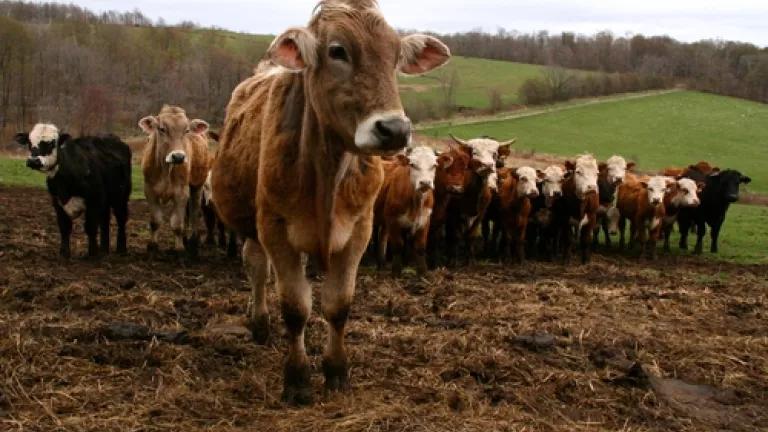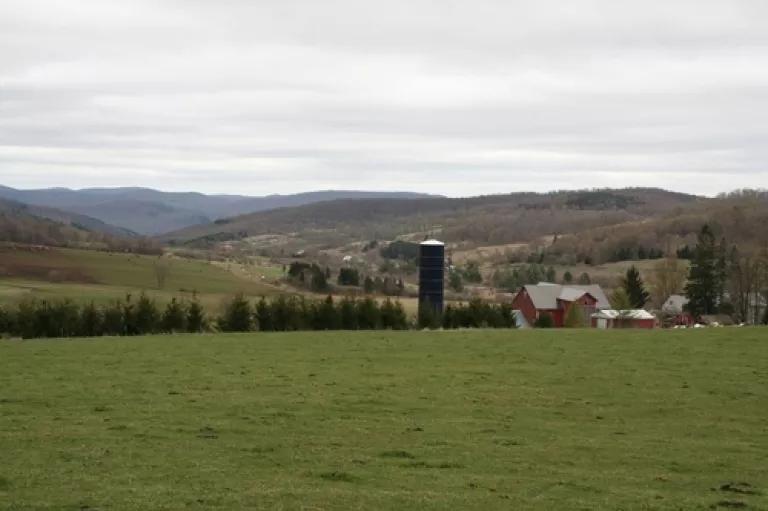
At the end of April, some members of the New York Urban Program and the Center for Market Innovation got out of the city and up to see some farms in Delaware County, NY. Despite our freezing hands and feet from the unseasonably low temperatures, it was a great day and a rare opportunity for us to witness firsthand the impact of food and agriculture on our land and natural resource base.
Delaware County is located in the Catskill Region of New York State, about 2.5 hours northwest of New York City. Like much of New York State, Delaware County has a strong agricultural history. Notably, a large portion of the county is within the city’s watershed, which supplies clean unfiltered drinking water to 8 million New Yorkers.
The purpose of our trip was to look at farms that raise grass-fed and grass-finished beef. It is important to note that beef marketed as grass-fed must also be finished on grass--meaning the animal has never been fed grain. Though all cattle are fed grass for some point in their lives only those that grass-fed and grass-finished have the accompanying environmental and human health benefits.
Although it was published 10 years ago, Michael Pollan’s Power Steer still gives a pretty accurate depiction of the lives of most beef cattle, which pass through feedlots or confined animal feeding operations (CAFOs) for fattening before slaughter, and parts are pretty grim. In the past 10 years, this industrialized production system has resulted in multiple public health scares, including e. coli outbreaks and mad cow disease. Concerns have also escalated amongst doctors, public health advocates, and consumers about the routine use of antibiotics for growth promotion in CAFOs, endangering our health by breeding antibiotic-resistant bacteria. Be sure to check out Avi Kar’s blog on NRDC’s work fighting antibiotic overuse in livestock production.
Yet, in various areas of upstate New York, an alternative beef production system is taking shape—one without the use of corn, hormones, or antibiotics. On a whole, New York State is well positioned to significantly expand the production of grass-fed and -finished beef. An abundance of fresh water, productive pastureland—3 million acres of unused pastureland as estimated by this Cornell report—and increased processing capacity can help meet growing demand for grass-finished beef from the downstate market, the largest metropolitan center in the country. This would give farmers and ranchers an opportunity to increase their economic viability, while providing consumers with a healthier alternative to conventionally raised beef.
There remain, of course, environmental and ethical concerns related to eating beef, regardless of how it was raised. Food thinkers like Mark Bittman have written at length on the problems associated with industrialized agriculture and the need to reduce our meat consumption even as we shift to consuming meat raised more sustainably and humanely. More research is needed on the carbon sequestration potential and water use of management intensive rotational grazing and the human health benefits of eating grass-finished beef. For instance, this new report by the National Trust gives a good sense of what is missing in the life cycle assessment for carbon footprint of beef. However, while this additional research is underway, there is good reason to believe that well-managed and appropriately sited grazing operations producing grass-finished beef can deliver significant ecological benefits and economic opportunities in regions like the Catskills, while also improving human health and animal welfare. NRDC is working on efforts to ensure that consumers get information they need to identify this type of beef.
Once we got up to Delaware County, our first stop was at a new USDA-approved slaughterhouse. Currently, four companies control 80% of the beef animals slaughtered in the United States. These large packing houses are linked to a feedlot system of beef production and therefore are virtually unworkable for small-scale pasture-based producers. While lack of processing facilities in the Northeast has been a real hurdle in linking regional livestock production to nearby urban markets, particularly for red meat, the opening of a number of new facilities in Delaware County in recent years has helped ease the problem. Our tour of the kill-floor and cutting room was interesting and sobering. While certainly not as enjoyable to visit as farms, independent slaughter facilities are key to a regional food system and we were glad to learn more about what that entails.
After leaving the processing facility, we headed to two nearby farms. The first stop was Spring Lake Farm, where Ingimundur Kjarval raises grass-fed and -finished beef and lamb, as well as pastured pork. He and Ken Jaffe, whose farm we visited next, discussed their beef operations and the conversation ranged from the difficulties in finding a good butcher to grass management and breeding. Ingimundur puts particular emphasis on the breeding of his herd and has focused on finding a breed that would fare well in the Catskill climate and finish well on pasture, thereby allowing the landscape to inform his farming practices. After Ingimundur and his family kindly hosted us for lunch, he gave us a tour of the farm and we were able to see for ourselves how carefully he cares for his land and animals.

A short drive from Spring Lake Farm brought us to Slope Farms, where Ken Jaffe took us out into the fields to see his cattle. Despite the cold weather, the pasture was beginning to grow in and the cattle stood about placidly watching us. Ken showed us the moveable electric fencing that allows him to rotationally graze his cattle, thereby significantly building up soil health. Just before we left, Ken opened the fencing to new pasture and the cattle bounded over to begin eating the fresh grass. Finally, we left the cattle and the cold, but it did seem at that moment, to quote Michael Pollan, that “the reciprocal relationship between cows and grass is one of nature’s underappreciated wonders.”


